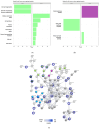Antifungal Synergy: Mechanistic Insights into the R-1-R Peptide and Bidens pilosa Extract as Potent Therapeutics against Candida spp. through Proteomics
- PMID: 39201622
- PMCID: PMC11354716
- DOI: 10.3390/ijms25168938
Antifungal Synergy: Mechanistic Insights into the R-1-R Peptide and Bidens pilosa Extract as Potent Therapeutics against Candida spp. through Proteomics
Abstract
Previous reports have demonstrated that the peptide derived from LfcinB, R-1-R, exhibits anti-Candida activity, which is enhanced when combined with an extract from the Bidens pilosa plant. However, the mechanism of action remains unexplored. In this research, a proteomic study was carried out, followed by a bioinformatic analysis and biological assays in both the SC5314 strain and a fluconazole-resistant isolate of Candida albicans after incubation with R-1-R. The proteomic data revealed that treatment with R-1-R led to the up-regulation of most differentially expressed proteins compared to the controls in both strains. These proteins are primarily involved in membrane and cell wall biosynthesis, membrane transport, oxidative stress response, the mitochondrial respiratory chain, and DNA damage response. Additionally, proteomic analysis of the C. albicans parental strain SC5314 treated with R-1-R combined with an ethanolic extract of B. pilosa was performed. The differentially expressed proteins following this combined treatment were involved in similar functional processes as those treated with the R-1-R peptide alone but were mostly down-regulated (data are available through ProteomeXchange with identifier PXD053558). Biological assays validated the proteomic results, evidencing cell surface damage, reactive oxygen species generation, and decreased mitochondrial membrane potential. These findings provide insights into the complex antifungal mechanisms of the R-1-R peptide and its combination with the B. pilosa extract, potentially informing future studies on natural product derivatives.
Keywords: Bidens pilosa; Candida albicans; ROS; antifungal resistance; bovine lactoferricin peptides; disfunction mitochondrial; proteomics.
Conflict of interest statement
The authors declare no conflicts of interest.
Figures













Similar articles
-
Combining the Peptide RWQWRWQWR and an Ethanolic Extract of Bidens pilosa Enhances the Activity against Sensitive and Resistant Candida albicans and C. auris Strains.J Fungi (Basel). 2023 Aug 2;9(8):817. doi: 10.3390/jof9080817. J Fungi (Basel). 2023. PMID: 37623588 Free PMC article.
-
Antifungal activity of Rubus chingii extract combined with fluconazole against fluconazole-resistant Candida albicans.Microbiol Immunol. 2016 Feb;60(2):82-92. doi: 10.1111/1348-0421.12357. Microbiol Immunol. 2016. PMID: 26891940
-
Oxidative stress induced by piperine leads to apoptosis in Candida albicans.Med Mycol. 2021 Apr 6;59(4):366-378. doi: 10.1093/mmy/myaa058. Med Mycol. 2021. PMID: 32658959
-
Structure-activity relationship studies of ultra-short peptides with potent activities against fluconazole-resistant Candida albicans.Eur J Med Chem. 2018 Apr 25;150:479-490. doi: 10.1016/j.ejmech.2018.03.027. Epub 2018 Mar 9. Eur J Med Chem. 2018. PMID: 29549835
-
Genome-wide expression profiling reveals genes associated with amphotericin B and fluconazole resistance in experimentally induced antifungal resistant isolates of Candida albicans.J Antimicrob Chemother. 2004 Aug;54(2):376-85. doi: 10.1093/jac/dkh336. Epub 2004 Jun 16. J Antimicrob Chemother. 2004. PMID: 15201233
Cited by
-
Special Issue "Antifungal Drug Discovery: Progresses, Challenges, Opportunities".Int J Mol Sci. 2025 Feb 27;26(5):2065. doi: 10.3390/ijms26052065. Int J Mol Sci. 2025. PMID: 40076689 Free PMC article.
-
Antiparasitic and Antifungal Activities of Cetyl-Maritima, a New N-Cetyl-Modified Maritima Derivative.Antibiotics (Basel). 2025 Mar 19;14(3):321. doi: 10.3390/antibiotics14030321. Antibiotics (Basel). 2025. PMID: 40149131 Free PMC article.
References
MeSH terms
Substances
Grants and funding
LinkOut - more resources
Full Text Sources
Molecular Biology Databases
Miscellaneous

